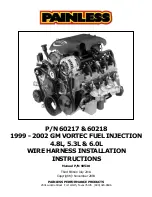
SECTION 6
ILMOR HIGH-PERFORMANCE OWNER’S MANUAL
6-2
Ilmor High-Performance Marine, LLC
© 7/2013, Version 1.0
During the break-in period, maintain the correct oil level to ensure that
the internal affected components are well lubricated. Watch the gauges
on the instrument panel closely, as they are the first line of defense. Well
before serious damage occurs to an engine, gauges can alert the operator to
circumstances that can lead to major damage.
Any abnormal vibrations or unusual noises may be symptomatic of
additional problems that are not registered by gauges or alarms. Do not
ignore them. Have an authorized Ilmor High-Performance Marine service
center check out anything that seems unusual. It may be a minor issue
that requires a simple tightening of screws or bolts, but it may also signal
serious internal issues.
Plane the boat quickly, as low speeds can place more strain on the engine
operation. This does not mean to slam the throttle/shift control lever
forward; rather a steady, quick hand will help achieve the goal.
BEFORE THE ENGINE IS STARTED
1. After performing all the checks and inspections outlined in this
Owner’s Manual, lift the engine compartment cover.
2.
DANGER!
Always, before starting the engine, open the engine
compartment and check for fumes, leaks or the presence of fluids
in the bilge.
Operate the bilge blower for at least 4 minutes with
the engine compartment cover open. Leave the bilge blower ON
throughout the starting process and until the boat has planed.
NOTE: Always start the engine with the throttle/shift control lever in the
neutral position. The boat is equipped with a neutral-start safety switch that
will not allow engines to start while in gear.
3.
WARNING!
Never operate the engine without an adequate amount
of water flowing without interruption through the cooling system.
The boat is likely to be equipped with sea strainer valves and seacocks.
Ensure these are open prior to starting the engine.
















































